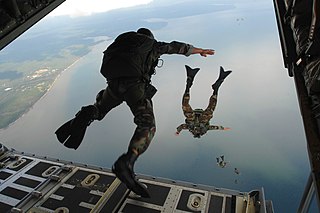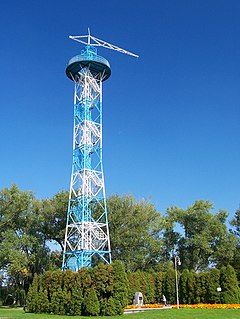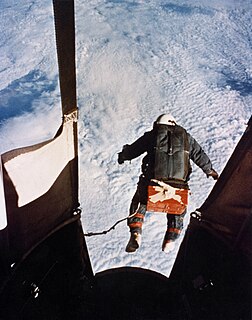 W
WA paratrooper is a military parachutist—someone trained to parachute into an operation, and usually functioning as part of an airborne force. Military parachutists (troops) and parachutes were first used on a large scale during World War II for troop distribution and transportation. Paratroopers are often used in surprise attacks, to seize strategic objectives such as airfields or bridges.
 W
WA paratrooper is a military parachutist—someone trained to parachute into an operation, and usually functioning as part of an airborne force. Military parachutists (troops) and parachutes were first used on a large scale during World War II for troop distribution and transportation. Paratroopers are often used in surprise attacks, to seize strategic objectives such as airfields or bridges.
 W
WThe 188th Glider Infantry Regiment was a regiment in the United States Army that was active during World War II. It was a part of the 11th Airborne Division during its entire existence.
 W
WThe 1st Airborne Division was an airborne infantry division of the British Army during the Second World War. The division was formed in late 1941 during World War II, after the British Prime Minister, Winston Churchill, demanded an airborne force, and was initially under command of Major-General Frederick A. M. Browning. The division was one of two airborne divisions raised by the British Army during the war, with the other being the 6th Airborne Division, created in May 1943, using former units of the 1st Airborne Division.
 W
WAirborne forces are ground combat units carried by aircraft and airdropped into battle zones, typically by parachuting. Foot soldiers serving an airborne force are known as airborne infantry or paratroopers.
 W
WA parachutist badge is a military badge awarded by the armed forces of many states to soldiers who receive the proper parachute training and accomplish the required number of jumps. It is difficult to assess which country was the first to introduce such an award.
 W
WCichociemni were elite special-operations paratroopers of the Polish Army in exile, created in Great Britain during World War II to operate in occupied Poland.
 W
WThe Fallschirmjäger were the paratrooper branch of the German Luftwaffe before and during World War II. They were the first German paratroopers to be committed in large-scale airborne operations. Throughout World War II the Fallschirmjäger commander was Kurt Student.
 W
WThe history of French airborne units began in the Interwar period when the French Armed Forces formed specialized paratroopers units. First formed in the French Air Force, they were rapidly integrated into the French Army, French Navy, National Gendarmerie and from the British Armed Forces. Some were later included in the postwar French Armed Forces.
 W
WHigh-altitude military parachuting is a method of delivering military personnel, military equipment, and other military supplies from a transport aircraft at a high altitude via free-fall parachute insertion. Two techniques are used: HALO and HAHO.
The Parachute Regiment is an airborne and special forces regiment of the Indian Army. It was raised in 1945 as part of the British Indian Army but was disbanded after the World War II and was re-raised in 1952 as part of the Indian Army. Currently it comprises seven Special Forces, six airborne, two Territorial Army and one Rashtriya Rifles battalions. The present Colonel of the regiment of the Parachute Regiment is Lt Gen Paramjit Singh Sangha.
 W
WJump boots are standard footgear for Paratroopers and Airborne Forces featuring calf-length lacing and rigid toe caps. The style is a type of combat boot and versions were developed in many countries simultaneously with the adoption of airborne infantry forces during World War II. Modern jump boots are earned in some countries and therefore have become a mark of achievement and distinction, mainly worn as dress and parade boots. The uppers are generally made of smooth black leather with toe-caps and heel counters that accept a high polish. It is also a paratrooper tradition to lace jump boots in a ladder or cobweb style which increases ankle support during a parachute jump.
 W
WJumpmasters are the expert paratroopers in an airborne unit who train and teach the military techniques for jumping from airplanes. They are responsible for training soldiers who enter Army Airborne School into paratroopers and managing airborne jump operations in airborne units across all branches of services.
 W
WThe Kazakh Ground Forces is the land service branch of the Armed Forces of the Republic of Kazakhstan. It is one of the three uniformed military services, and is the most senior branch of the Kazakh military in order of precedence. The main tasks of the Ground Forces include the following: maintaining the readiness of troops to repel aggression, the armed defense of the territorial integrity and sovereignty of Kazakhstan, protecting the state and military facilities, peacekeeping missions. In its duties, it primarily engages in land warfare and combined arms operations, including armored and mechanized operations as well as airborne and air assault operations. It is headed by a chief military officer, the Commander of the Ground Forces who is also a member of the General Staff.
 W
WThe Paracadutisti are a speciality of the Italian army's infantry corps.
 W
WA parachute is a device used to slow the motion of an object through an atmosphere by creating drag. Parachutes are usually made out of light, strong fabric, originally silk, now most commonly nylon. They are typically dome-shaped, but vary, with rectangles, inverted domes, and others found. A variety of loads are attached to parachutes, including people, food, equipment, space capsules, and bombs.
 W
WAirborne forces are ground combat units carried by aircraft and airdropped into battle zones, typically by parachuting. Foot soldiers serving an airborne force are known as airborne infantry or paratroopers.
 W
WThe Parachute Regiment and Airborne Forces Museum is based at Duxford in Cambridgeshire and tells the story of the Parachute Regiment and other airborne forces.
 W
WA parachute tower is a tower used for parachute training, often by members of a military paratroop unit. A mixture of tower heights are used at different stages of training. Trainees typically begin on towers around 35 feet (11 m) in height in fall-arrest harnesses before progressing onto parachute descents from towers that can be in excess of 250 feet (76 m). The use of towers allows trainees to practice their landing technique before jumping from an aircraft.
 W
WJump boots are standard footgear for Paratroopers and Airborne Forces featuring calf-length lacing and rigid toe caps. The style is a type of combat boot and versions were developed in many countries simultaneously with the adoption of airborne infantry forces during World War II. Modern jump boots are earned in some countries and therefore have become a mark of achievement and distinction, mainly worn as dress and parade boots. The uppers are generally made of smooth black leather with toe-caps and heel counters that accept a high polish. It is also a paratrooper tradition to lace jump boots in a ladder or cobweb style which increases ankle support during a parachute jump.
 W
WThe 35th Brigade, also known as the Paratroopers Brigade, is an infantry brigade unit of paratroopers within the Israel Defense Forces (IDF), and forms a major part of the Infantry Corps. It has a history of carrying out special forces-style missions dating back to the 1950s.
 W
WThe Specialized Forces Corps is the air force infantry and special forces corps of the Indonesian Air Force ("TNI-AU"). The corps is also known as the Orange Berets from the colour of their service headgear. Paskhas is trained to seize and defend airfields from enemy forces known as Operasi Pembentukan dan Pengoperasian Pangkalan Udara Depan , airborne operations, and other specific military operations within the scope of the Indonesian Air Force.
 W
WIn military organizations, a pathfinder is a specialized soldier inserted or dropped into place in order to set up and operate drop zones, pickup zones, and helicopter landing sites for airborne operations, air resupply operations, or other air operations in support of the ground unit commander. Pathfinders first appeared in World War II, where they served with distinction, and continue to serve an important role in today's modern armed forces, providing commanders with the option of flexibly employing air assets.
 W
WThe Portuguese Paratroop Nurses were a group of 46 women that, between 1961 and 1974, became the first women to be integrated into the Portuguese Armed Forces.
 W
WProject Excelsior was a series of parachute jumps made by Joseph Kittinger of the United States Air Force in 1959 and 1960 from helium balloons in the stratosphere. The purpose was to test the Beaupre multi-stage parachute system intended to be used by pilots ejecting from high altitude. In one of these jumps Kittinger set world records for the longest parachute drogue fall, the highest parachute jump, and the fastest speed by a human through the atmosphere. He held the latter two of these records for 52 years, until they were broken by Felix Baumgartner of the Red Bull Stratos project in 2012, though he still holds the world record for longest time in free fall.
 W
WThe Russian Airborne Forces or VDV is a separate troops branch of the Armed Forces of the Russian Federation. First formed before World War II, the force undertook two significant airborne operations and a number of smaller jumps during the war and for many years after 1945 was the largest airborne force in the world. The force was split after the dissolution of the Soviet Union, losing divisions to Belarus and Ukraine, and has been reduced in size.
 W
WThe Russian Airborne Forces or VDV is a separate troops branch of the Armed Forces of the Russian Federation. First formed before World War II, the force undertook two significant airborne operations and a number of smaller jumps during the war and for many years after 1945 was the largest airborne force in the world. The force was split after the dissolution of the Soviet Union, losing divisions to Belarus and Ukraine, and has been reduced in size.
 W
WThe Special Airborne Force (SABF) also known as Special Airborne Wing is the first elite special force in Sri Lanka Air Force and forms part of the SLAF Regiment. It provides air assault capabilities and VVIP protection. Formed out of the Administrative Regiment Branch in 1989 by Air Vice Marshal Oliver Ranasinghe, it initially under took counter insurgency operations during the 1987–1989 JVP insurrection. In the Sri Lankan Civil War it provided VIP protection under the Chief Provost Marshal, until it was transferred to the Directorate of Ground Operations.